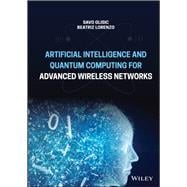A comprehensive presentation of the implementation of artificial intelligence and quantum computing technology in large-scale communication networks
Increasingly dense and flexible wireless networks require the use of artificial intelligence (AI) for planning network deployment, optimization, and dynamic control. Machine learning algorithms are now often used to predict traffic and network state in order to reserve resources for smooth communication with high reliability and low latency.
In Artificial Intelligence and Quantum Computing for Advanced Wireless Networks, the authors deliver a practical and timely review of AI-based learning algorithms, with several case studies in both Python and R. The book discusses the game-theory-based learning algorithms used in decision making, along with various specific applications in wireless networks, like channel, network state, and traffic prediction. Additional chapters include Fundamentals of ML, Artificial Neural Networks (NN), Explainable and Graph NN, Learning Equilibria and Games, AI Algorithms in Networks, Fundamentals of Quantum Communications, Quantum Channel, Information Theory and Error Correction, Quantum Optimization Theory, and Quantum Internet, to name a few.
The authors offer readers an intuitive and accessible path from basic topics on machine learning through advanced concepts and techniques in quantum networks. Readers will benefit from:
- A thorough introduction to the fundamentals of machine learning algorithms, including linear and logistic regression, decision trees, random forests, bagging, boosting, and support vector machines
- An exploration of artificial neural networks, including multilayer neural networks, training and backpropagation, FIR architecture spatial-temporal representations, quantum ML, quantum information theory, fundamentals of quantum internet, and more
- Discussions of explainable neural networks and XAI
- Examinations of graph neural networks, including learning algorithms and linear and nonlinear GNNs in both classical and quantum computing technology
Perfect for network engineers, researchers, and graduate and masters students in computer science and electrical engineering, Artificial Intelligence and Quantum Computing for Advanced Wireless Networks is also an indispensable resource for IT support staff, along with policymakers and regulators who work in technology.









